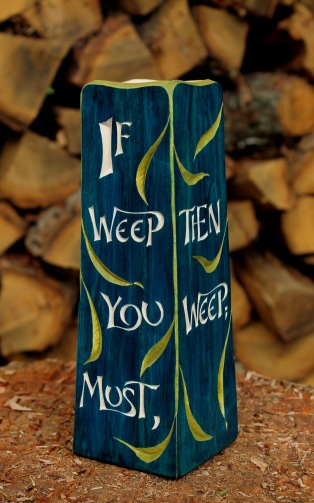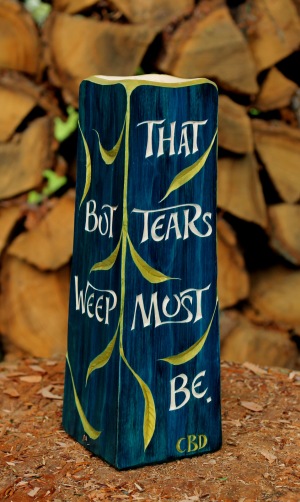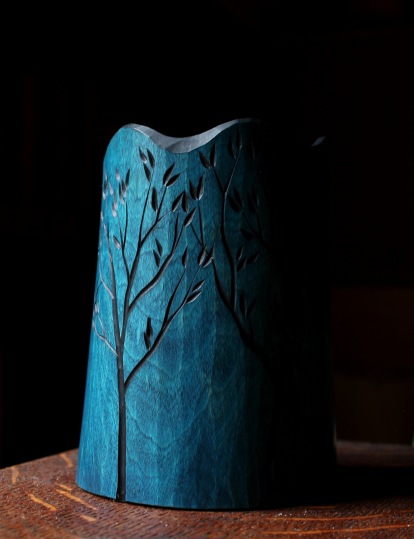

If weep you must, then weep; but weep that tears must be, and be
Gentle and grow as, weeping to the ground, the willow tree;
And grace will come, lighting the eyes of heaven, after thee.
— Catherine Breese Davis, Be Graced
The shrink pot above is the result of being asked to design and make a shrink pot to feature a portion of a beloved poem. This pot, as well as a couple others, will let me share some brief thoughts on lettering and painting ideas I’ve been exploring.
The CBD shrink pot above has a square base; as long as the pith was in the middle, the pot walls will shrink around a square as well. This is the same idea as the rectangular base of the book style shrink pots like the one you can see part way down this post. After boring a 2″ hole through, I used a long gouge to shape the tapering square hollow of the interior.
The outside was textured with long loose cuts with a wide shallow gouge, then painted with a couple different layers of glazes of thinned artist oil paints. After carving the willow leaves, I added another layer of thin green, and wiped it off the surface of the rest of the pot. Then I cut the letters, leaving them the natural color of the aspen wood.
 I used a similar technique on this shrink pot to the right. After painting a very thin, and relatively bright, blue over the pot, I carved the trees and the undulating rim. Then I painted a thin black over all, wiping the surface completely right after; like applying and wiping off wood stain. The black pigment was accepted readily by the bare wood of the trees and rim. However, on the surface that had been painted a bright blue, it only deepened the color of the blue to a sort of twilight blue.
I used a similar technique on this shrink pot to the right. After painting a very thin, and relatively bright, blue over the pot, I carved the trees and the undulating rim. Then I painted a thin black over all, wiping the surface completely right after; like applying and wiping off wood stain. The black pigment was accepted readily by the bare wood of the trees and rim. However, on the surface that had been painted a bright blue, it only deepened the color of the blue to a sort of twilight blue.
There are many other ways to play around with different color combinations and carving sequences.
Of course, there are still many occasions where I want the character of the wood to speak for itself. The slide show below shows a cherry shrink pot made by request for a wedding gift. The couple was married in the mountains of Indonesia, and the words refer to how the couple met.

Sharpen your knife and make some chips.

Wow. Just WOW. ❤
LikeLiked by 2 people
The beauty and excellence of your work defy my vocabulary. Suffice it to say that seeing your work brings joy to my day.
LikeLiked by 2 people
Deeply appreciated, Nancy. Thanks.
LikeLiked by 1 person
Unscrupulous new owners at work have sapped my will but not my desire to carve lately. Your latest work is a most welcome reminder, inspiration and pick-me-up.
Lovely poem. Calligraphy seems under appreciated in the west. The Japanese and Chinese have long appreciated it as art. Carving it though, gives it the prominence it deserves. Love your carved trees, always, and oil paints too. 😉
I found some small, paint-splattered, old gouges, 2 nice old saws & a small, minor brand block plane at recent car-boot sales. I enjoy restoring & sharpening them but can’t face it currently, more pressing matters to deal with first.
LikeLiked by 1 person
Don’t let ’em get you down, Tony! I hope some carving and tool restoration will take some things off your mind when you get the opportunity. Best wishes.
LikeLiked by 1 person
David,
The colors in your work are beautifully vibrant. Are the oil paints standard artists’ oils? Do you thin the oil paints with the boiled linseed oil available at big box stores?
Thanks for continuing your blog despite the popularity of Instagram. I appreciate the detail you provide.
Regards, Michael
LikeLiked by 2 people
Thanks, Michael. Just standard artists’ oils from the aluminum tubes, so just a mix of linseed oil and pigment. I have a small selection in a mix of various brands. I thin with raw cold-pressed linseed oil and sometimes a bit of citrus solvent. I don’t know what I’m doing so I just mess around until it seems right and gives me the effect I’m after. Lots of that-didn’t-work moments, but experiments can be done with just a tiny bit of paint, so there’s not much waste.
Dry time can be a few days depending on the consistency of the paint and the color. As with pure oil, I often use heat to speed that up a bit — whether in the sun, by the wood stove, or in my small light bulb kiln.
LikeLiked by 1 person
Thank you Dave, I will get some paint and see what I come up with!
LikeLiked by 1 person
David- give me a bare-bones description of paint types, consistency of the thinned paint, etc.
Art
LikeLiked by 1 person
Art, see my reply to Michael above for the first part of your question. As far as consistency, it varies greatly from oil with a little bit of paint to a lot of paint with a little oil. Just depends on what I’m trying to do, how much wood grain I want to show through, etc. I hope for the best and sometimes I’m pleasantly surprised.
LikeLiked by 1 person
Beautiful Dave. I really like the painted version, but for me, it’s hard to beat the natural cherry. I’m sure the lucky couple will be forever grateful to you and the requester.
LikeLiked by 3 people
Brother Thomas, battling a fit of dissatisfaction, was admonished by a master….. “Just work.”
You go, Dave.
LikeLiked by 1 person
Love the anecdote, Scott. Thanks. I’ll strive for that. Throwing a few projects into one post inadvertently made me look more productive than I am!
Hope the water has cleared for you down there and things are getting back to normal.
LikeLiked by 1 person
Dave, you are a living example of what happens when one takes the advice offered to Brother Thomas to heart. Like you said, “Sharpen your knife and make some chips”.
LikeLiked by 1 person
Hi David,
Can you give some lettering design resources? I know you once mentioned that stone carving books have a lot of design inspiration.
LikeLiked by 1 person
Hi Nate. My favorite is “The Art of Letter Carving in Stone” by Tom Perkins. It did a lot to open my eyes to how much is possible in terms of letter design. “Lettercarving in Wood” by Chris Pye is also includes some inspiring examples and instruction. And Martin Wenham’s lettering in wood just blows me away. You can see some examples of it here https://www.goldmarkart.com/gallery/artist/martin-wenham
LikeLiked by 1 person
Perhaps you have addressed this somewhere before, but does a square pot have a square base plate or is still roundish?
LikeLiked by 1 person
The base, as well as the whole interior, is square. I do round the corners a bit rather than bringing them to distinct points.
LikeLiked by 1 person
Hi David,
The couple married in Indonesia who received your lovely shrink pot loved the special gift. It is still in Indonesia sitting on Fath’s shelf. She is awaiting Visa approval and with the government shut down it is straining her patience. Jess is trying to keep entertained by taking her shopping via the Internet to outfit their apartment.
Thanks so much for this treasured gift.
LikeLike
Wonderful to know that, Cindy. Thanks for letting me know. Hoping all works out well and expeditiously for Fath’s Visa approval.
LikeLike
I am always in awe of your beautiful creations. An update on Jess and Fath. Fath arrived in Seattle January 2020. Lockdown was terribly hard as Fath loves to travel. They moved to Portland two years ago when Jess got a job at Nike and she obtained her Masters at Portland State University during those two years. They found a lovely little Westie to make their family of three, have made trips to Virginia, California, Washington state, and of course around Oregon. They just returned from a visit to Indonesia. Your shrink pot is proudly displayed on their bookshelf.
LikeLiked by 1 person
It’s wonderful to hear that, Cindy. Thanks very much for the update on their lives of adventure and the shrink pot.
LikeLike
Hi David,
You seem to carve effortlessly and it seems that you just put the letters in a way that suits the piece you are carving, does the inspiration to carve letters come naturally to you or had you gotten ideas from others carvers ?
Thank you,
Mario
LikeLike
Hi Mario,
I appreciate the compliment that it seems that I do it effortlessly. Actually, both the designing and the carving of the letters are challenges, but wonderful ones. I enjoy interpreting an inscription and adapting the lettering to the piece. Yes, I am naturally drawn to it, and I’ve been inspired by the work of other carvers, in both wood and stone. Not so much in specific letter forms, but especially in terms of how their work has shown me the incredible expressiveness possible with lettering. Martin Wenham’s work is a good example: https://davidffisher.com/2022/06/28/martin-wenhams-letter-carving-book/
LikeLike